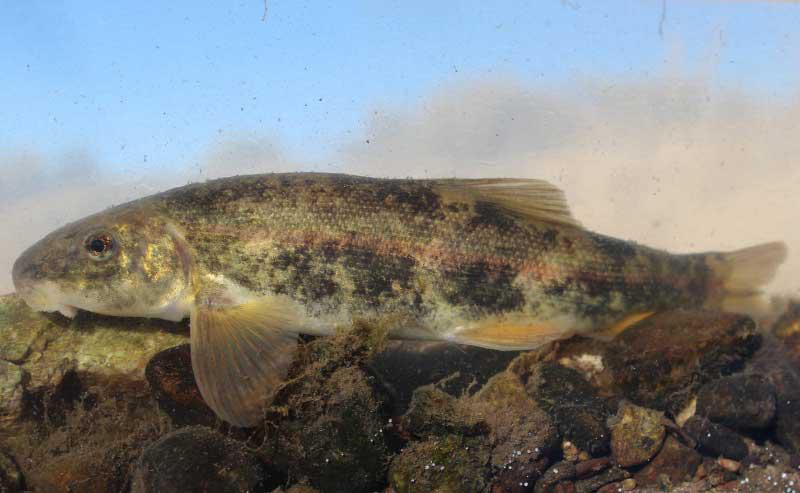CPW applauds USFWS decision on Rio Grande chub, sucker

 John Livingston
John LivingstonSouthwest Region Public Information Officer
970-759-9590 / [email protected]
@CPW_SW

Colorado Parks and Wildlife commended the USFWS for its June 17 decision that acknowledged critical partnerships that have ensured neither species is in danger of extinction or likely to become in danger of extinction.
“CPW staff have worked tirelessly for decades to ensure Rio Grande chub and sucker continue to persist,” said Matt Nicholl, CPW’s Assistant Director of Aquatic Wildlife. “The responsibility of successfully managing these two species deeply aligns with our mission, and we are thankful for the continued support and collaboration with all of the partners who have made this announcement possible.”
CPW along with several agencies and species experts consulted with the USFWS during its status review for each of the cool-water fish species that occur within the Rio Grande Basin.
For several decades, CPW and multiple partners including federal agencies, states, tribes, municipalities, non-government organizations and private landowners have worked to conserve the two species and implement long-term management actions to ensure their persistence.
“CPW has provided steady leadership in the recovery of Rio Grande sucker and Rio Grande chub, though this progress has always been mediated through strong partnerships,” said CPW Native Species Aquatic Biologist Daniel Cammack. “Through a shared commitment to execute the meaningful and collaborative conservation actions, the future for these important native species is bright.”
Historic accounts suggest that Rio Grande chub and sucker were some of the most common fishes in the Rio Grande and its tributaries, though declines were evident as early as the late 1800s because of dewatering, habitat degradation and invasive species establishment. Recognizing significant declines, CPW initiated conservation efforts of these species in the early 1990s.
Work included translocations to establish new populations, broodstock development, genetic testing, invasive species removal and habitat protection and enhancement. CPW identified both species as Tier I Species of Greatest Conservation Need under the State Wildlife Action Plan and designated Rio Grande sucker as State Endangered and Rio Grande chub as a Species of Special Concern.
Over the past three decades, CPW and its partners have completed five chemical reclamations and numerous habitat and connectivity enhancements related to these species. The CPW Native Aquatic Species Restoration Facility (NASRF) in Alamosa has served a critical role in recovering both fishes, innovating novel culture techniques and writing the book for production methods of these fish.
“Since 2002, NASRF has stocked nearly 450,000 Rio Grande suckers in 20 waters and 1.2 million Rio Grande chub in 11 waters,” Cammack said.
CPW maintains two Rio Grande sucker broodstocks and seven Rio Grande chub broodstocks to sufficiently represent genetic diversity within Colorado and has produced fish for the New Mexico Department of Game and Fish to support repatriation projects for the partner agency.
Cammack said CPW’s aquatic biologists have worked tirelessly to monitor and conserve aboriginal populations and to identify suitable habitats for reintroduction efforts.
“Synergy between field biologists and hatchery staff has translated to reestablishing multiple populations of both species in the San Luis Valley,” he said. “This progress is especially evident for Rio Grande sucker, as there were only two self-sustaining populations of this species in Colorado by the early 2000s. Now, there are eight established sucker populations with multiple other reintroduction sites showing great promise.”
Following the 2014 petition to list these species under the ESA, CPW coalesced with multiple state and federal agencies, tribal entities and other stakeholders throughout the species’ range to form the Rio Grande Chub and Sucker Conservation Team.
In 2018, a Conservation Agreement with 12 signatories, including CPW, was finalized to implement carefully coordinated conservation measures for both species to mitigate the threats that could eventually lead to their federal listing under the ESA. The conservation team collaborated on a Conservation Strategy for each species, which was adopted in 2021.
Over the past two years, species experts from CPW have served on the Technical Advisory Team to support USFWS in developing a Species Status Assessment (SSA) for each species. This included providing thorough input on early drafts of the SSA and enhancing the scientific accuracy and defensibility of this document to support an informed listing decision.
“CPW biologists played a significant role in the writing of this strategy, which details specific conservation actions and collaborative approaches that will reduce and/or eliminate threats to the long-term viability of both species,” Cammack said. “Following this announcement from the USFWS, we look forward to continued partnership with the conservation team as we continue to advance conservation goals for these unique species.”
CPW also thanks all of the partners that have helped lead to the success of Rio Grande chub and sucker recovery.
Partners:
New Mexico Department of Game and Fish (NMDGF)
U.S. Forest Service (USFS)
U.S. Fish and Wildlife Service (USFWS)
Taos Pueblo
Texas Parks and Wildlife Department (TPWD)
Jicarilla Apache Nation
National Park Service (NPS)
Bureau of Land Management (BLM)
Turner Enterprises, Inc.
Pueblo of Santa Ana
Coalition of Colorado Counties
Trinchera Ranches
Trout Unlimited
Rio Grande Water Conservation District
Multiple private landowners
 Rio Grande Chub
Rio Grande Chub
Colorado Parks and Wildlife (CPW) is an enterprise agency, relying primarily on license sales, state parks fees and registration fees to support its operations, including: 43 state parks and more than 350 wildlife areas covering approximately 900,000 acres, management of fishing and hunting, wildlife watching, camping, motorized and non-motorized trails, boating and outdoor education. CPW's work contributes approximately $6 billion in total economic impact annually throughout Colorado.
DISCLAIMER: The Colorado Parks and Wildlife (CPW) website maintains press releases containing historical information that may no longer be accurate. Press releases are dated, which should be noted to determine whether the information provided is current. Please review our current regulations and brochures for up-to-date information.